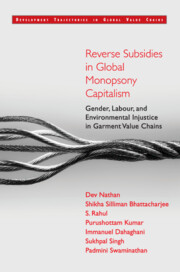 Reverse Subsidies in Global Monopsony Capitalism
Reverse Subsidies in Global Monopsony Capitalism 3 - Knowledge, Global Monopoly–Monopsony Capitalism, and Labour
Published online by Cambridge University Press: 21 January 2022
Summary
This chapter explores the relations between the structure of global value chains (GVCs) and labour employment in developing countries where downstream suppliers are largely concentrated. As laid out in the introduction to this book, this starts with knowledge, usually protected under intellectual property rights (IPRs), creating oligopolies or monopolies with degrees of monopoly in the product markets in the headquarter economies of lead firms. In an unequal world—unequal in the distribution of knowledge, incomes, and wages—there is the possibility of utilizing these differences to increase the profits of product monopolies through the disintegration of production in GVCs.
GVCs have embedded within them a distribution of knowledge among different GVC segments: knowledge-intensive segments in pre- and post-production tasks, which are protected under IPRs in lead firms; and production knowledge distributed among many suppliers in developing economies that is not protected under IPRs. The monopolies on the product market then appear as monopsonies in input markets, where a few buyers can bargain with many suppliers to the buyers’ advantage. In the resulting distribution of value within the value chain, the lead firms earn rents (or super profits), while the suppliers just earn competitive profits.
Before proceeding, let us revisit our terminology, as clarified in the introduction, once again. The technical term for a market with a few buyers and many suppliers is an oligopsony, while that for a market with a few sellers and many buyers is an oligopoly. Not only is oligopsony a somewhat clumsy word, but it is not very commonly used. The term ‘monopsony’ can be extended to describe a market where a few players on one side deal with many players on the other side. In this way, there are brands with degrees of monopoly in the product market and also degrees of monopsony in the input market.
The relationship between lead firms and suppliers has been analysed under the rubric of value chain governance (Gereffi, Humphrey, and Sturgeon 2005). The theory of supplier firm governance divides them into three types of governance, in which we emphasize differentiation based on the knowledge level of the tasks performed. Suppliers in captive governance are characterized by the low-knowledge level of tasks performed, as seen in the manufacture of garments or shoes. There is an intermediate level of knowledge in supplier firms in modular governance, as seen in automobile and electronics assemblies.
- Type
- Chapter
- Information
- Reverse Subsidies in Global Monopsony CapitalismGender, Labour, and Environmental Injustice in Garment Value Chains, pp. 48 - 68Publisher: Cambridge University PressPrint publication year: 2022
